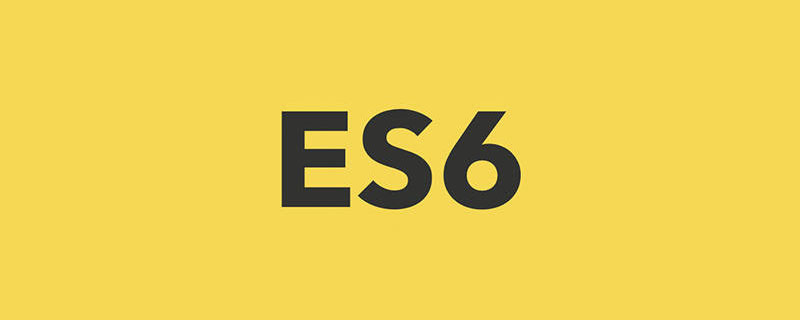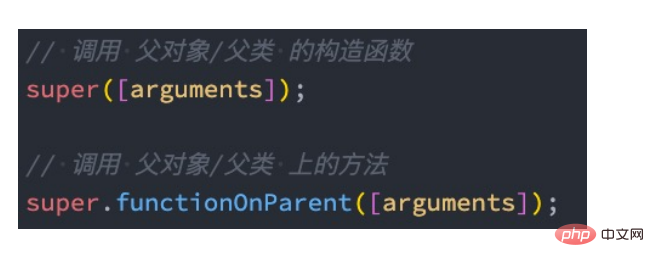
The class class is es6 syntax and is a new feature of es6. In ES6, the class keyword was introduced to quickly define a "class", but the essence of a class is function; it can be regarded as a syntactic sugar, making the writing of object prototypes clearer and more like the syntax of object-oriented programming. Use class to define the class method "class Person{//class declaration}" or "const Person=class{//class expression}".

The operating environment of this tutorial: Windows 7 system, ECMAScript version 6, Dell G3 computer.
The class class is es6 syntax and is a new feature of es6.
In ES6, the class keyword was introduced to quickly define "classes".
In JS, the essence of "class" is function, which can be regarded as a syntactic sugar, making the writing method of object prototype more concise and clear, more like the syntax of object-oriented programming.
We will find that creating a class according to the previous constructor form is not only too similar to writing an ordinary function , and the code is not easy to understand.
In the new standard of ES6 (ECMAScript2015), the class keyword is used to directly define the class; but the class is still essentially the syntax sugar of the constructor and prototype chain mentioned earlier. ;So learning the previous constructors and prototype chains will help us understand the concept and inheritance relationship of classes;
So, how to use class to define a class? –You can use two ways to declare a class: class declaration and class expression;
class Person{
//类声明
}
const Person=class{
//类表达式
}Let’s Study some characteristics of the class: you will find that it is actually consistent with the characteristics of our constructor;
console.log(Person.prototype) console.log(Person.prototype.__proto__)//Object null console.log(Person.prototype.constructor)//Person console.log(typeof Person) // function var p = new Person() console.log(p.__proto__ === Person.prototype) // true
If we want to When creating an object, you pass some parameters to the class. What should you do at this time?
When we operate a class through the new keyword, this constructor function will be called and the following operations will be performed:
The properties we defined above are all placed directly on this, which means that it is placed on the created In the new object:
We said before that for instance methods, we hope to put them on the prototype so that they can be shared by multiple instances; Defined in the class;
class Person {
constructor(name, age) {
this.name = name
this.age = age
this._address = "广州市"
}
// 普通的实例方法
// 创建出来的对象进行访问
// var p = new Person()
// p.eating()
eating() {
console.log(this.name + " eating~")
}
running() {
console.log(this.name + " running~")
}
}class Person {
constructor(name, age) {
this.name = name
this.age = age
this._address = "广州市"
}
// 类的访问器方法
get address() {
console.log("拦截访问操作")
return this._address
}
set address(newAddress) {
console.log("拦截设置操作")
this._address = newAddress
}
}class Person {
constructor(name, age) {
this.name = name
this.age = age
this._address = "广州市"
}
// 类的静态方法(类方法)
// Person.createPerson()
static randomPerson() {
var nameIndex = Math.floor(Math.random() * names.length)
var name = names[nameIndex]
var age = Math.floor(Math.random() * 100)
return new Person(name, age)
}
}class Person{
}
class Student extends Person{
}
There are three places where super can be used: constructors of subclasses, instance methods, and static methods;
 ##Inherit built-in classes
##Inherit built-in classes
class HYArray extends Array {
firstItem() {
return this[0]
}
lastItem() {
return this[this.length-1]
}
}
var arr = new HYArray(1, 2, 3)
console.log(arr.firstItem())
console.log(arr.lastItem())Class mixin
面向对象的三大特性:封装、继承、多态。
前面两个我们都已经详细解析过了,接下来我们讨论一下JavaScript的多态。JavaScript有多态吗?
维基百科对多态的定义:多态(英语:polymorphism)指为不同数据类型的实体提供统一的接口,或使用一
个单一的符号来表示多个不同的类型。
非常的抽象,个人的总结:不同的数据类型进行同一个操作,表现出不同的行为,就是多态的体现。
那么从上面的定义来看,JavaScript是一定存在多态的。
// 多态: 当对不同的数据类型执行同一个操作时, 如果表现出来的行为(形态)不一样, 那么就是多态的体现.
function calcArea(foo) {
console.log(foo.getArea())
}
var obj1 = {
name: "why",
getArea: function() {
return 1000
}
}
class Person {
getArea() {
return 100
}
}
var p = new Person()
calcArea(obj1)
calcArea(p)
// 也是多态的体现
function sum(m, n) {
return m + n
}
sum(20, 30)
sum("abc", "cba")// 传统的面向对象多态是有三个前提:
// 1> 必须有继承(是多态的前提)
// 2> 必须有重写(子类重写父类的方法)
// 3> 必须有父类引用指向子类对象
// Shape形状
class Shape {
getArea() {}
}
class Rectangle extends Shape {
getArea() {
return 100
}
}
class Circle extends Shape {
getArea() {
return 200
}
}
var r = new Rectangle()
var c = new Circle()
// 多态: 当对不同的数据类型执行同一个操作时, 如果表现出来的行为(形态)不一样, 那么就是多态的体现.
function calcArea(shape: Shape) {
console.log(shape.getArea())
}
calcArea(r)
calcArea(c)
export {}【相关推荐:javascript视频教程、编程视频】
The above is the detailed content of Is the class class an es6 syntax?. For more information, please follow other related articles on the PHP Chinese website!